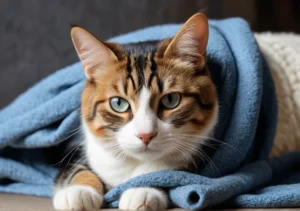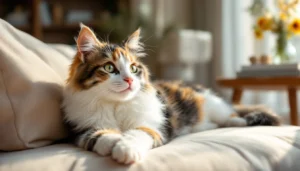Cats are fascinating creatures with many quirky behaviors, one of which is clawing when they knead. Have you ever wondered why your feline friend engages in this curious habit? Let’s explore the reasons behind why cats claw when they knead.
Cats claw when they knead to mark their territory with scent glands located in their paw pads, to stretch their muscles, and to show contentment and relaxation. Understanding this behavior can give you insight into your cat’s emotional state and help strengthen your bond with your furry companion.
Territorial Marking and Scent Glands
Have you ever noticed your cat kneading and clawing at your furniture or blankets? While this behavior may seem destructive, it actually serves a vital purpose for our feline friends. When cats knead and claw, they are not only stretching their muscles but also engaging in a form of territorial marking.
Cats have scent glands located in the pads of their paws. By clawing and kneading at various surfaces, they are leaving behind their scent as a way to mark their territory. This behavior helps cats communicate with other felines in the area, sending subtle messages about their presence and ownership of a specific space.
So next time you catch your cat in the act of clawing and kneading, remember that they are simply expressing their natural instincts to mark their territory and communicate with other cats in the area.
Pro Tip: Provide your cat with designated scratching posts to redirect their natural urge to claw and knead towards appropriate surfaces, saving your furniture from damage.
Muscle Stretching and Maintenance
When your cat kneads and claws at a soft blanket or your lap, they are not just showing affection – they are also taking care of their physical well-being. This behavior serves as a form of stretching that helps cats maintain healthy muscles and promote circulation in their paws.
By kneading and clawing, cats engage multiple muscle groups in their shoulders, back, and legs, promoting flexibility and preventing stiffness. This rhythmic motion also helps them relax and release tension, contributing to their overall physical maintenance.
So the next time your cat kneads on your lap, appreciate the fact that they are not only showing you love but also taking care of their physical health through this natural behavior.
And remember, providing your cat with regular playtime and exercise opportunities can further support their muscle stretching and maintenance needs, keeping them happy and healthy for years to come.
Emotional Expression and Contentment
Cats claw when they knead as a way to express contentment and relaxation. This behavior is a sign that your furry friend feels safe, comfortable, and happy in their environment. When a cat kneads with their claws out, it’s like a gentle massage for them, releasing feel-good endorphins and creating a cozy atmosphere. So, next time you see your cat kneading and clawing, know that they’re simply showing you that they are content and at peace.
Evolutionary Behavior and Instincts
The act of clawing and kneading in cats dates back to their wild ancestors, where these behaviors served important functions for survival and communication. Cats in the wild would use their claws to knead on soft surfaces to create a comfortable resting spot or to mark their territory with scent glands on their paws. This instinct has been passed down through generations, even though indoor cats may not need to knead for the same reasons. It’s a fascinating insight into the evolutionary roots of these seemingly simple actions.
Additional Unique Insight:
- Cats may also claw when they knead to stretch and exercise the muscles in their paws, promoting healthy circulation and flexibility. So, by indulging in this natural behavior, cats are not only expressing contentment but also taking care of their physical well-being.
Training and Redirecting Clawing Behavior
If you’ve ever wondered why your cat claws when they knead, the answer lies in their natural instincts. Cats knead as a way to mark their territory and create a comfortable space, much like how they would knead in the wild to create a cozy sleeping spot. The kneading motion involves using their claws, which is why you may notice them coming out during this behavior.
To prevent your furniture from becoming a scratching post, it’s important to train and redirect your cat’s clawing behavior. Introduce scratching posts or pads that are enticing to your feline friend – consider ones made of sisal or corrugated cardboard. Encourage your cat to use these designated scratching surfaces by placing treats or catnip nearby to entice them. Consistency is key, so be patient and reward your cat when they use the appropriate scratching area.
Training Tip: If you catch your cat clawing furniture, gently redirect them to the scratching post and praise them when they use it. Positive reinforcement goes a long way in encouraging good behavior.
Remember, understanding why cats claw when they knead can help you train them effectively and save your furniture from scratches.
Health Considerations and Claw Care
Apart from providing proper outlets for your cat to scratch, it’s essential to look after their claw health. Regular nail trimming can prevent issues like ingrown nails and promote healthy claw maintenance. If you’re unsure how to trim your cat’s claws, it’s best to consult with your veterinarian for guidance.
In addition to trimming, having scratching outlets like posts or pads can also help keep your cat’s claws in good condition. When cats scratch, they are not only marking their territory but also shedding the outer layers of their claws. This shedding process keeps their claws healthy and prevents them from becoming overgrown.
To further promote healthy claws, consider providing a variety of textures for scratching surfaces. Cats have individual preferences, so offering different materials like carpet, wood, or cardboard can cater to your cat’s specific needs.
Health Tip: Check your cat’s claws regularly for any signs of damage or overgrowth. If you notice any issues, don’t hesitate to seek advice from your veterinarian.
By understanding the reasons behind why cats claw when they knead and taking proactive steps to care for their claws, you can ensure your feline companion enjoys good claw health and exhibits appropriate scratching behavior.
Interaction and Bonding with Your Cat
Kneading is a soothing behavior for cats, reminiscent of when they were kittens nursing from their mothers. When your feline friend kneads on you with their claws out, it’s a display of comfort and trust. Engaging with your cat during these moments can strengthen your bond; pet them gently or talk to them in a calm, soothing tone. This simple act can deepen your emotional connection and make your cat feel loved and secure.
Fun Facts About Cat Claws
Did you know that cats’ claws are retractable, like a built-in extension cord? This amazing feature helps them stay sharp for hunting, climbing, and defending themselves. Cats use their claws not just for kneading, but also for marking their territory and stretching their muscles. Fun fact: A cat’s claw can retract far enough to avoid wearing down when walking, keeping them sharp and ready for action.
By understanding the reasons behind your cat’s kneading behavior and the fascinating facts about their claws, you can better appreciate and care for your furry companion. Take the time to engage with your cat during these special moments, and embrace the unique characteristics of their claws that make them such skilled and agile creatures. Your bond with your cat will only grow stronger as you learn more about their natural instincts and behaviors.
Alex, a passionate animal lover, has experience in training and understanding animal behavior. As a proud pet parent to two dogs and three cats, he founded AnimalReport.net to share insights from animal experts and expand his knowledge of the animal kingdom.




